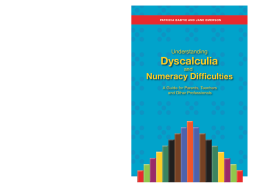
Additional Information
Book Details
Abstract
Dyscalculia is a specific learning difficulty that affects the acquisition of numerical skills. A far larger number of pupils, while not dyscalculic, fail to acquire the basic numerical skills required for everyday life.
Whatever the cause of poor numeracy it is essential that these difficulties are identified and addressed. This book looks at how adults can help identify each child's specific areas of difficulty and describes a multi-sensory approach that can be adapted for the needs of each student to help them better understand numbers and apply that understanding to solve problems. It covers the origins of number sense and how the brain deals with numbers, assessment, planning intervention, what to teach and how to teach it, and how parents can help their children.
This straightforward guide will be essential reading for any parent, teacher or education professional working with a child with dyscalculia or numeracy difficulties.
This is a comprehensive and accessible overview of the many factors involved in understanding dyscalculia, from definitions to legislation to intervention.
Professor Steve Chinn, PhD, FRSA, editor of 'The Routledge International Handbook of Dyscalculia and Mathematical Learning Difficulties'
Patricia Babtie has taught children and adults with maths learning difficulties since 1998. She is particularly interested in devising ways to make SEN interventions easier to integrate into the classroom, and in developing ways to engage parents. Jane Emerson is Director of Emerson House, a renowned centre for dyslexia, dyscalculia and dyspraxia, in London. She is a speech and language therapist with more than 25 years' experience of working with primary age children. She lectures widely and is recognised as a leader in the field of identifying and teaching children with specific learning difficulties. Jane has run a dyscalculia training course for teachers and SENCOs for several years. Both authors live in London.
What a great book! Divided into two clear sections, the first half gives a very accessible and useful overview and explanation of a range of difficulties impacting on numeracy. The second half of the book then focuses on 'how to teach it' in an easy-to-understand, step-by-step layout using verbal, visual, and multisensory strategies useful for so many learners. It also includes a really useful chapter for parents and carers on how to support their children at home. I would be happy to recommend it to my colleagues in school.
Jane Trapmore, Cornwall Dyslexia Service
Babtie and Emerson have made their way through a thicket of jargon-dense research and come out the other side with a one-stop shop for understanding dyscalculia. The title is too modest. Understanding Dyscalculia and Numeracy Difficulties does so much more than make sense of this little understood condition, it provides practical advice for working through it that in our modern, math-filled world has the power to make all the difference in your student's life.
Hunter Maats, educator and author of 'The Straight-A Conspiracy'
